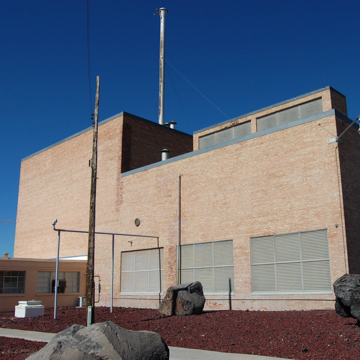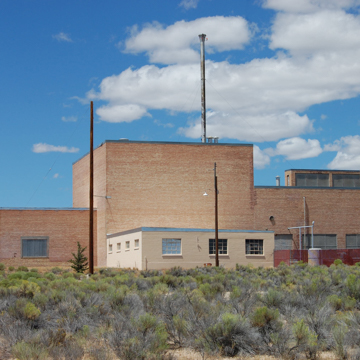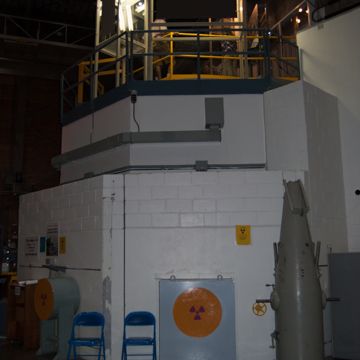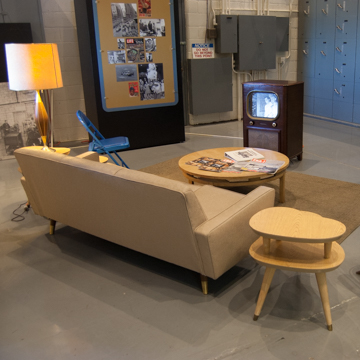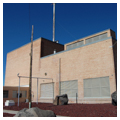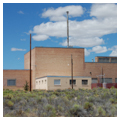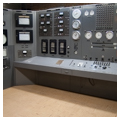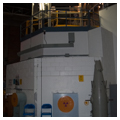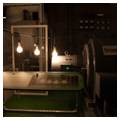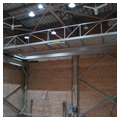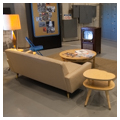You are here
EBR-1 Atomic Museum
The significance of Experimental Breeder Reactor 1 (EBR-1) lies not with the building itself, but with the innovation that occurred within. EBR-1 was the site of a milestone in nuclear energy research, which spawned an international industry that provides about 14 percent of the world’s electricity today.
Scientists such as Enrico Fermi and Walter Zinn first conceived of the idea of a breeder reactor while working on the U.S. wartime atomic program in the early 1940s. As uranium was in short supply at the time and the Atomic Energy Commission (AEC) aimed to develop peaceful uses of the atom, AEC planned to create the first power reactor and use it to attempt to prove the theory of fuel breeding. EBR-1’s primary mission was to develop and test the concept of a nuclear breeder reactor. The AEC established the National Reactor Testing Station (now Idaho National Laboratory) in southeastern Idaho in 1949. The site was chosen for its isolation, abundant water available in the aquifer, and the unlikelihood of an earthquake. Today this is the location of the largest collection of experimental breeder reactors in the world, a place where research has been conducted on safety, materials testing, electrical power generation, and naval propulsion.
The EBR-1 building—with its reinforced concrete basement, heavy steel frame, lead and concrete shields, and specialized equipment—is quite heavy and required a solid, earthquake-resistant foundation. Once architects determined the depth of the building’s basement, they located EBR-1 where testing revealed that the depth of gravels overlaying volcanic bedrock matched the basement depth, thus minimizing the blasting of lava rock.
The AEC began drilling the EBR-1 well and constructing the EBR-1 building in 1949. Bechtel Corporation erected the building and conventional parts of the plant; this took about a year. It took another year to install the reactor and specialized equipment. Zinn, then director of the Argonne National Laboratory, became director of the EBR-1 project. He led Argonne scientists and engineers in designing the reactor and then in 1951 the team moved to Idaho to install the reactor, piping, pumps, heat exchangers, instrumentation, and critical material. EBR-1, the first major building of the National Reactor Testing Station, was completed by April 1951 for approximately $2.7 million.
The building is an unadorned rectangular brick structure with three levels: a basement, first floor, and partial second floor. The basement contained rooms for equipment. The first floor housed the reactor in the center of a solid, concrete-and-lead structure. The top of the reactor was at the second-floor level, as were the control room, turbine generator, and offices. Exterior walls were constructed of buff-colored brick laid in common bond, chosen by Zinn because he liked the appearance and it was relatively inexpensive.
The south section of EBR-1, the location of the reactor, is taller than the north so as to accommodate a traveling crane supported by a steel frame set inside the brick walls. This crane was designed to lift two-ton concrete “casks” into which highly radioactive spent fuel rods were placed before moving them from the reactor to a washing area and finally to storage holes in the floor collectively known as the rod farm.
The reactor itself is shielded by several feet of concrete and lead. The reactor is made of three concentric units: the central core of Uranium 235 fuel rods, an inner “blanket” of Uranium 238 fuel rods, and a denser outer “breeding blanket” of Uranium 238. The outer blanket is made of keystone-shaped uranium blocks that are assembled to create a cylinder that can slide up to surround the core and inner blanket and increase the power of the reactor or slide down to shut off the reaction.
The north section of the building contains the control room and a generator. At EBR-1, the nuclear fuel created heat by nuclear fission, which was carried from the reactor core by liquid metal, an alloy of sodium potassium (NaK). This heated a second system of liquid metal, also NaK, which heated water to make steam and drive the generator.
The first attempt to operate the reactor, in May 1951, was unsuccessful because the core did not have adequate fuel. In August 1951, Zinn and his staff brought EBR-1 to criticality and low-power operation. By December 20, 1951, the reactor was powered up to the point where the first usable amount of electricity ever generated from nuclear power flowed from the turbine generator and illuminated four 200-watt lightbulbs. The following day, the reactor generated enough electricity to power the EBR-1 building.
EBR-1’s primary objective was to determine whether more nuclear fuel could be created in a reactor than was consumed during operation. On June 4, 1953, the AEC announced that EBR-1 had become the first reactor to successfully breed plutonium from uranium. EBR-1 was also the first reactor to demonstrate the feasibility of using liquid metal (NaK) as a high-temperature liquid coolant.
EBR-1 operated until 1963, was decommissioned in 1964, and designated as a National Historic Landmark by President Lyndon Johnson in 1966. In 1973, plans were made to open EBR-1 to the public. Although it has been cleaned and decontaminated, hazardous materials removed, and building cavities filled with concrete, it still contains most of the equipment in the building dating to its period of operation. EBR-1 opened as a museum on June 14, 1975 and continues to operate as a museum each summer. Battelle Energy Alliance maintains the building for the U.S. Department of Energy.
References
“Experimental Breeder Reactor-I.” Idaho National Laboratory. Fact Sheet. Accessed January 15, 2019. https://www.inl.gov/.
Idaho National Laboratory. EBR-1 Atomic Museum: Self-Guided Tour. Pamphlet. Idaho National Laboratory, n.d.
“Koch: Remembering the EBR-1.” Nuclear News(November 2001), 30-35.
Plastino, Ben. “INEL History.” Bonneville County Heritage Association. Accessed January 15, 2019. http://www.bonnevilleheritage.com/.
Rick Michael, “50 Years Ago in December: Atomic Reactor EBR-1 Produced First Electricity.” Nuclear News(November 2001): 28-29.
Schroer, Blanche, “Environmental Breeder Reactor #1,” Butte County, Idaho. National Register of Historic Places Inventory-Nomination Form, 1976 and 1984. National Park Service, U.S. Department of the Interior, Washington, D.C.
Stacy, Susan M. Proving the Principle. Idaho Falls: Idaho Operations of the Department of Energy, 2000.
Writing Credits
If SAH Archipedia has been useful to you, please consider supporting it.
SAH Archipedia tells the story of the United States through its buildings, landscapes, and cities. This freely available resource empowers the public with authoritative knowledge that deepens their understanding and appreciation of the built environment. But the Society of Architectural Historians, which created SAH Archipedia with University of Virginia Press, needs your support to maintain the high-caliber research, writing, photography, cartography, editing, design, and programming that make SAH Archipedia a trusted online resource available to all who value the history of place, heritage tourism, and learning.

